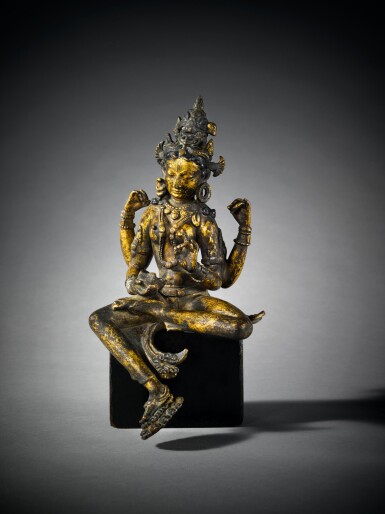
Property of a New England Collection
A Gilt Copper Alloy Figure Depicting Mahalakshmi, Nepal, 13th/14th Century
Auction Closed
September 20, 05:33 PM GMT
Estimate
40,000 - 60,000 USD
Lot Details
Description
Property of a New England Collection
A Gilt Copper Alloy Figure Depicting Mahalakshmi
Nepal, 13th/14th Century
Height 6¼ in. (15.9 cm)
the four-armed goddess seated in lalitasana, holding a kapala in her primary right hand, wearing a dhoti clasped at the waist with a jeweled belt, the fabric cascading around the body in swirling pleats, decorated with bracelets, armbands, layers of necklaces, mismatched earrings and foliate tiara surmounted by a kirtimukha, the face with gentle and contemplative expression
Himalayan Art Resources item no. 13786.
Mahalakshmi, the great goddess, is the epitome of beauty and grace. The divine mother sits in elegant equipoise in the posture of royal ease with the sash of the dhoti swaying with the gentle rhythm of her body. The secondary arms are folded at the elbow and raised towards the shoulders with weightless ease. The right hand gently cups a kapala, identifying her as the divine mother, while the other hand displays delicately folded fingers in shunya mudra. The slender limbs are decorated with bangles at the wrists, her neck adorned with a pendant necklace and long string of beads which falls between her breasts. The face in full serenity is framed by ornamental mismatched earrings and the head crowned with a foliate kirtimukha tiara. Sashes flair out from the crown, as the hair cascades in two braided locks over her shoulders.
Mahalakshmi would originally have been part of a larger set, depicting the Ashtamatrika, or “eight mothers” who were worshipped by Hindus and Buddhists alike in the Kathmandu valley. The mother goddesses were believed to aid with fertility and act as the protector of newborns. The subject of the Ashtamatrika was recurring during the thirteenth and fourteenth century and a comparable copper cast depicting Mahalakshmi shows similarly styled mismatched earrings, elongated limbs, a tall chignon framed by a foliate tiara, a dhoti with fluttering pleats and a kapala gently placed in the goddess’ right palm (U. von Schroeder, Indo-Tibetan Bronzes, Hong Kong, 1981, p. 353, pl. 92C.) A cast of Varahi, another of the eight matrikas, likely coming from the same set, shows identical styling of the jewelry and patterning of the dhoti as well as a lotus base supporting the pendent right foot (see Pratapaditya Pal, Nepal: Where the Gods Are Young, New York, 1975, p. 129, cat no. 70, illus. p. 102). Other examples of matrikas include a cast of Brahmani, whose graceful posture and details including the kapala and kirtimukha crown also relate to the present sculpture (U. von Schroeder, ibid., p. 353, pl. 92F).
The graceful rendering of an Uma-Maheshvara whose gestural movements and style mirror that of Mahalakshmi dates by inscription to 1345, confirming the period in which the present sculpture was made (I. Alsop, "Five Dated Nepalese Metal Sculptures", in Artibus Asiae, VOL. XLV, 2/3, 1984, pp. 207-22, fig. 3).
You May Also Like










